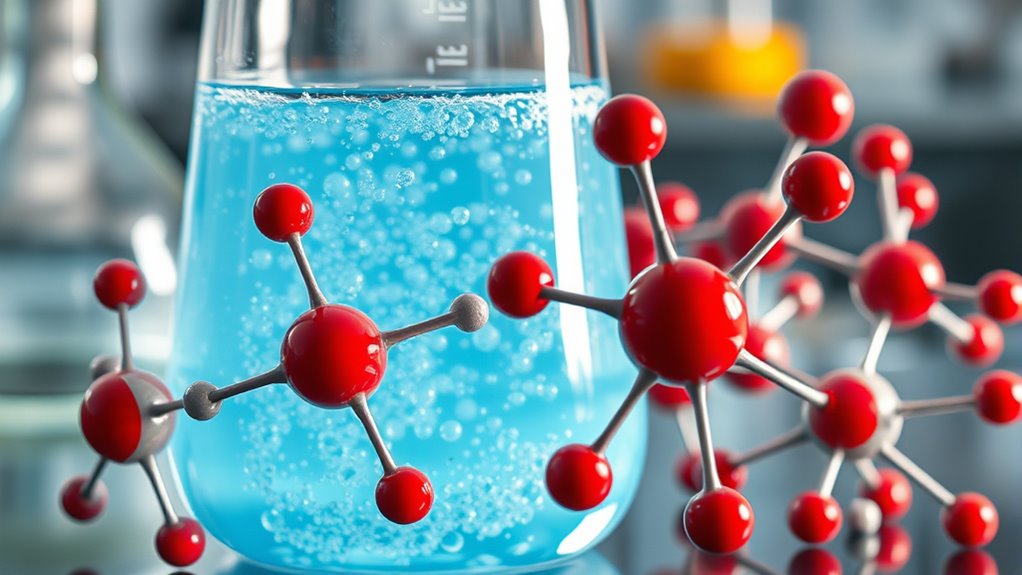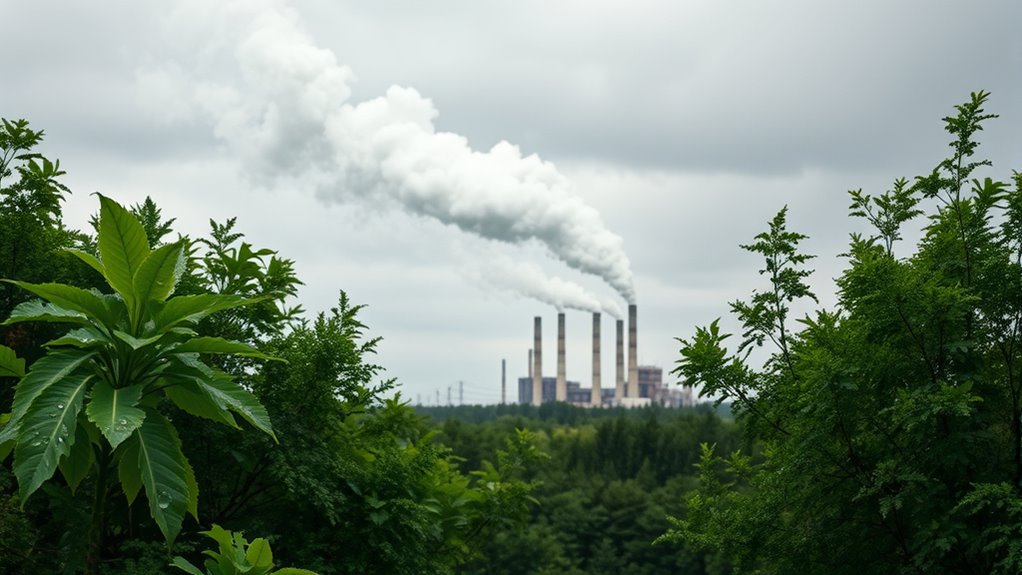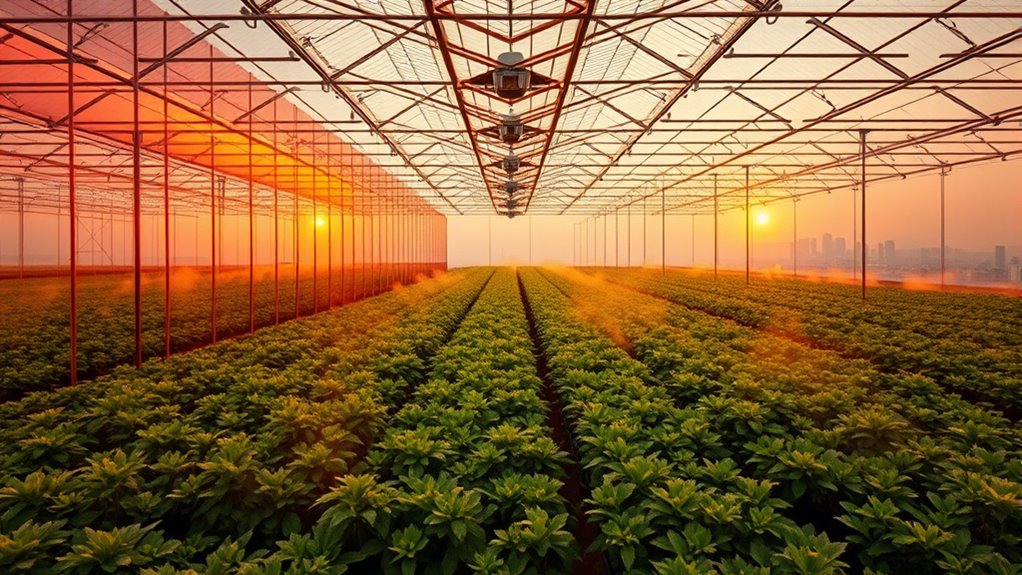Greenhouse gases like CO₂ absorb infrared radiation from Earth’s surface, trapping heat and warming the planet. CO₂’s molecules vibrate at specific wavelengths, mainly around 15 microns, allowing them to re-emit infrared energy in all directions, including back to the surface. Human activities, such as burning fossil fuels, increase CO₂ levels, intensifying the greenhouse effect. Understanding how these gases absorb and emit infrared radiation reveals the chemistry behind climate change; explore further to see how this process impacts global warming.
Key Takeaways
- Greenhouse gases like CO₂ absorb infrared radiation at specific wavelengths, trapping heat in Earth’s atmosphere.
- CO₂’s molecular structure enables vibrational modes that resonate with IR radiation, facilitating its warming effect.
- Human activities increase CO₂ levels, enhancing the greenhouse effect and accelerating climate change.
- CO₂ has a long atmospheric lifetime, making its warming impact persistent over thousands of years.
- Natural sinks such as forests and oceans help absorb CO₂, but are limited and affected by human land use.
Understanding the Role of CO₂ in Earth’s Atmosphere

Carbon dioxide (CO₂) plays a critical role in keeping Earth warm enough to support life by trapping heat through the natural greenhouse effect. It helps maintain temperatures above freezing, making the planet habitable.
Since the Industrial Revolution, CO₂ levels have risen by about 50%, from 280 ppm to over 427 ppm in 2024, mainly due to human activities like burning fossil fuels, cement production, deforestation, and biomass burning.
This increase intensifies the greenhouse effect, causing global warming and climate change. The long-term fluctuations of CO₂ over Earth’s history show that current levels are unprecedented in the past 14 million years, highlighting the urgency of addressing human contributions to climate change.
CO₂ is also essential for photosynthesis, enabling plants to produce oxygen and organic compounds. Additionally, it influences the oceanic carbon cycle, affecting how much CO₂ the oceans store.
While forests and oceans act as carbon sinks, their capacity is limited, and excess CO₂ disrupts these natural balances.
How Greenhouse Gases Absorb and Re-Emit Infrared Radiation

Greenhouse gases trap heat in the atmosphere by absorbing infrared radiation emitted from Earth’s surface. When the planet warms, it releases infrared energy, which molecules of greenhouse gases like CO₂, methane, and water vapor absorb at specific wavelengths due to molecular vibrations. After absorption, these gases re-emit infrared radiation in all directions, including back toward the surface, trapping heat. This process creates a cycle of absorption and re-emission, redistributing energy within the atmosphere. Understanding the trustworthiness of AI models like GPT-4 is essential for developing reliable tools to analyze climate data and support environmental research.
Comparing Climate Impact: GWP and Atmospheric Lifetimes

To understand how different gases influence Earth’s climate, it’s essential to compare their global warming potential (GWP) and atmospheric lifetimes. GWP measures how much heat a gas traps over 100 years relative to CO₂, serving as a comparison tool. GWP accounts for both the radiative efficiency and the atmospheric lifetime of gases, making it a comprehensive metric. For example, methane’s GWP-100 is about 27 to 30, meaning it warms much more than CO₂ over a century but less over longer periods. Atmospheric lifetime varies; CO₂ persists for thousands of years, while methane lasts about a decade. These differences affect how each gas impacts climate over various timeframes. Understanding the climate impact of gases over different durations] helps you evaluate emission impacts and guides policy decisions for targeted reductions and climate strategies.
Chemical Processes Behind Greenhouse Gas Absorption

Understanding how atmospheric gases trap heat depends on their ability to absorb infrared radiation. Greenhouse gases like CO₂, methane, and water vapor absorb specific wavelengths of infrared light. For example, CO₂ absorbs around 15 microns, effectively trapping heat. Their molecular structures enable this absorption by allowing vibrational modes that resonate with infrared radiation. The following table illustrates key gases and their absorption features:
| Greenhouse Gas | Key Infrared Wavelength | Chemical Structure |
|---|---|---|
| CO₂ | ~15 microns | Linear, double bonds |
| CH₄ | 7.7 microns | Tetrahedral, C-H bonds |
| H₂O | Broad spectrum | Bent, polar molecule |
| Halocarbons | Varies | Complex, halogenated |
| Water vapor | Multiple bands | Bent, polar molecule |
This process is essential for greenhouse warming, as gases re-emit absorbed energy, maintaining Earth’s temperature. Additionally, the molecular vibrational modes of these gases are crucial for their ability to absorb and emit infrared radiation effectively.
Sources and Sinks: The Balance of Greenhouse Gases

Balancing the amount of greenhouse gases in the atmosphere depends on the dynamic interplay between sources that emit these gases and sinks that remove them. Major sources include transportation, which burns petroleum fuels in cars, trucks, ships, trains, and planes, and electricity generation, mainly from coal and natural gas.
Industrial activities and agriculture also release significant amounts of methane, nitrous oxide, and CO₂. Deforestation and land-use changes further increase emissions by releasing stored carbon. Natural processes like photosynthesis and ocean absorption are vital in removing CO₂ from the atmosphere. Natural sinks, like forests, oceans, soils, and wetlands, absorb CO₂ and help offset emissions. Forests and land management practices can boost carbon storage, while urbanization reduces natural sinks. Enhanced sequestration techniques are being explored to improve the capacity of natural sinks.
Achieving a balance requires matching emissions with removals, often through natural processes or advanced technologies, to prevent continuous greenhouse gas buildup and climate change acceleration.
The Effects of Rising CO₂ Levels on Global Climate Systems

Rising CO₂ levels have a profound impact on the Earth’s climate system by trapping more heat in the atmosphere. As CO₂ increases by 50% in less than 200 years, it amplifies the greenhouse effect, raising global temperatures.
Since the late 19th century, surface temperatures have risen about 1.2°C, with polar and northern regions warming even more. This trapping of infrared heat disrupts the energy balance, causing uneven warming.
The warming accelerates ice melt, reducing Earth’s reflectivity and increasing absorption of solar energy. It also boosts water vapor, a potent greenhouse gas, creating a feedback loop.
These changes lead to intensified weather events, shifting ocean currents, rising sea levels, and altered ecosystems, all driven by the sustained presence of elevated CO₂ in our atmosphere. Additionally, climate feedback mechanisms play a crucial role in accelerating these effects, leading to more unpredictable and extreme climate phenomena.
Frequently Asked Questions
How Does Co₂ Interact With Other Atmospheric Components?
You see, CO₂ interacts with other atmospheric components mainly through indirect effects. It reacts with water to form carbonic acid, influencing acidity.
By trapping heat, it raises temperatures, which impacts water vapor and cloud formation. CO₂ also affects ecosystems, altering nitrogen and methane cycles.
Although it doesn’t react directly with gases like O₂ or N₂, its warming influence changes atmospheric chemistry and interactions, shaping the environment around you.
Can Greenhouse Gases Be Naturally Removed From the Atmosphere?
Yes, greenhouse gases can be naturally removed from the atmosphere. You should know that processes like photosynthesis in plants and forests absorb CO₂, storing it in biomass and soils.
Oceans also play a role by absorbing CO₂, and wetlands or peatlands sequester carbon over long periods. However, human activities like deforestation and pollution can reduce these natural removal processes, making it harder to keep greenhouse gases in check.
What Role Do Human Activities Play in Greenhouse Gas Increases?
You might think nature balances itself, but human activities tip the scales. Burning fossil fuels for electricity, heat, and transportation releases vast amounts of greenhouse gases, especially CO₂.
Deforestation reduces natural carbon sinks, further increasing emissions. These actions disrupt the natural atmospheric balance, trapping more heat and accelerating climate change.
Your choices and policies directly influence the level of greenhouse gases, making human activity a key driver of rising global temperatures.
How Do Greenhouse Gases Influence Ocean Chemistry?
Greenhouse gases, mainly CO₂, influence ocean chemistry by dissolving into seawater and forming carbonic acid.
As this acid dissociates, it releases hydrogen ions, lowering the ocean’s pH and causing acidification.
This process reduces carbonate ions, which marine creatures need to build shells and skeletons.
You should understand that this chemical shift impacts marine life, ecosystems, and the ocean’s ability to absorb CO₂, creating a feedback loop.
Are There Natural Feedback Mechanisms That Accelerate Climate Change?
Yes, there are natural feedback mechanisms that speed up climate change. When temperatures rise, water vapor increases, trapping more heat.
Melting ice reduces Earth’s reflectivity, absorbing more solar energy.
Thawing permafrost releases methane, a potent greenhouse gas, further warming the atmosphere.
Additionally, forest fires and land changes release gases and decrease carbon sinks, all of which amplify warming and accelerate climate change.
Conclusion
Think of CO₂ as Earth’s invisible heartbeat, pulsing with every breath we take. Its rise signals a shifting climate, like a storm gathering on the horizon. By understanding its chemistry, you hold the power to turn the tide—acting as a guardian of this delicate balance. Together, you can help restore harmony, ensuring our planet’s symphony continues to play in tune for generations to come.









